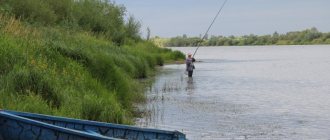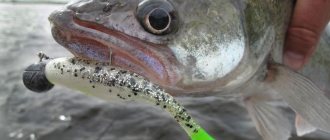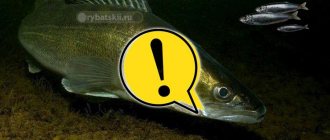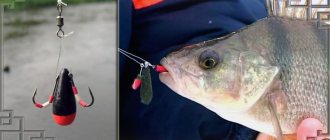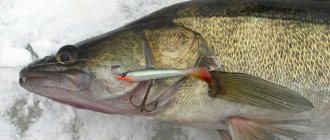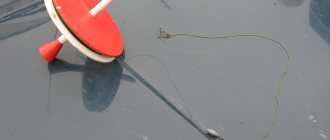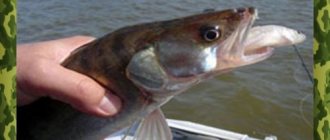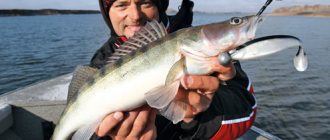Winter fishing for pike perch is popular among lovers of quiet hunting. Catching such a predator involves using any bait.
But it is sprat that is more suitable for passive fish in the dead months of winter. There are several principles and rules of fishing that need to be learned. Then a good catch cannot be avoided.
The principle of catching pike perch using sprat in winter
For successful winter fishing for pike perch using sprat, it is advisable to use the following principles:
- Choose places with dumps where there are strong water movements.
- The best fishing will occur 30 cm from the bottom surface.
- Lower the tackle into the hole with jerky, but not sudden movements. The vibration amplitude of the bit is 30 cm. Swings must be done every 5 seconds. As soon as the bait drops the required distance from the bottom, the game ends.
- Coat the jig with a special luminescent coating. It will attract fish.
- Frozen bait works best for bait. Fishing with live bait is a waste of time.
Note! It is recommended to master fishing with sprat using simple gear: one hook, a jig head with a round weight. Later, you can start testing other variations, using larger jigs, helicopters, and rigs. The length of the forend must be chosen less than the bait.
Sequence of actions during fishing:
- drill a hole in a place suitable for fishing;
- attach bait, lower it into the pond;
- The sprat should touch the bottom. Take time. 10 seconds is enough;
- make two turns using the coil. As a result, the jig head should rise to a distance of 30 cm from the bottom;
- make a small smooth swing with the rod. Another pause. The more passive the fish is at the time of fishing, the greater the pause and amplitude of oscillations.
Let's celebrate! During a sluggish bite, it is important to attract the attention of an inactive predator - start tapping the bait on the bottom. The mud will rise a little, and the pike perch will bite on the sprat. You need to catch the caught fish quickly, without delay. You should not allow indecision, thereby allowing the catch to come to its senses and begin sharp resistance.
Place and time of fishing
Pike perch is a predator. And he behaves accordingly - he constantly hunts. It tracks prey in underwater rubble and often changes ambush sites. These can be holes, hills, stones, as well as snags.
The best time to hunt pike perch is a winter evening. At such times, the predator is more active. The chances of successful fishing will increase - the fish will notice the bait faster. In December, it is advisable to start catching pike perch early in the morning, from lunch until evening.
Advantages and disadvantages of fishing with sprat
The method of using sprat as bait has pros and cons.
Advantages:
- Low price. Bait in the form of this dead fish is inexpensive. Therefore, there is no need to buy expensive baits.
- High probability of catching a lot of fish.
- Possibility of preparing your own bait. Fry can be purchased in advance. They keep well in the freezer.
- Versatility. The sprat is also suitable for hunting other predators.
- Easy to catch.
- This bait “works” in any winter month. The other one may not fit. It is the sprat that will attract predators with its smell. It also bears a strong resemblance to live fish.
Flaws:
- You should buy dead fish in advance and prepare it yourself. And not everyone will like this;
- You need to freeze the bait properly. Otherwise, yellowness will form on it. Then the fishing will be ruined.
How to catch pike perch using sprat - technique
Winter fishing for this fish involves the use of two types of equipment:
- Passive way. You can fish with tackle that is stationary. For example, a retractable leash. The planted sprat needs to be lowered to the bottom. Then secure the rod with a stand. This method is suitable for fishing with currents, which make the bait mobile. The smell of the equipment will spread throughout the pond. The fisherman just needs to wait for the bite. This type of technique is successful on a tried and tested pond or river.
- A method of rhythmically tossing equipment. The amplitude of oscillation is conveniently 10-15 cm. It is necessary to maintain a minute pause. The second type of technique resembles jig play with smooth movement of the equipment. You can choose a jig head, as well as a jig. Infrequent tapping of the sprat on the bottom will do.
Good to know! It is recommended to combine and diversify both techniques so that fishing is effective. It is important to remember to move smoothly. It’s better to forget about the sharpness and sweep.
How to choose and where to get sprat?
The bait can be purchased at any fish store or at a special “Everything for Fishing” store. Many fishermen prepare sprat themselves, catching it after the first frost and storing it in the freezer.
If the choice falls on a fish store, experienced fishermen strongly recommend choosing fresh fish and then freezing it. Moreover, it is recommended to store it in several bags. For fishing for pike perch, freshly frozen dead fish 4-5 cm long are suitable. Some are sure that it is good to freeze it in a bag of water.
Many fishermen complain about the quality of purchased sprat in frozen form - when defrosted before the baiting procedure, the bait fell off the bones and became unusable.
Note! Therefore, if you want a successful hunt, you should still catch sprat yourself or take it freshly caught in proven places.
How to properly place a sprat on a hook?
There are several types of dead fish:
- For the lower jaw. A hook is inserted into the nostrils of the bait. The advantage of this method is that the live bait remains in a state of movement for a long time. There is also a minus - sometimes the predator removes the sprat.
- Through the mouth. This part of the bait is the beginning of the hook, which must be brought out through the dorsal fin. This method is good if the bait is small.
- Through the tail. The most commonly used attachment method. The popularity is explained by the strong fastening of the sprat to the hook. At the same time, the bait attracts pike perch from a distance with its movement.
How to plant a sprat?
The question in the title is not accidental. After all, in order to successfully catch pike perch, you need to properly attach the sprat. Many beginners try to choose fatter and larger fish, guided by the proverb about a big piece. However, practice has established that bait longer than five centimeters is not completely swallowed by fanged fish. He just bites off a piece and swims on.
The second rule relates to the method of baiting. When fishing in still water, it is necessary to place the sprat closer to the tail. The pike perch swallows prey from the head, so when hooking, the hook will better penetrate its mouth.
If you are going to fish in the current, then it is better to place the sprat across the body so that the carcass glides better on the current.
Where to look for pike perch?
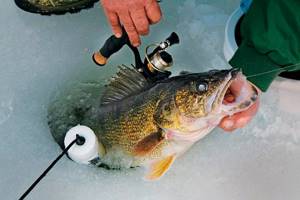
There are no special secrets in finding fishing spots. You need to look for pike perch in winter anchorages.
Experienced fishermen use several characteristic “signs” of the area:
- places near bridges;
- long ditches, as well as impressive pits;
- coastal edges;
- channel dumps.
There are places where it is inconvenient to catch pike perch due to the presence of snags. There the bait can get caught. Although some fishermen prefer snags.
They also have a chance of catching a predator using modern lures. Reservoirs are a good choice. You should look for pike perch in the upper part of the reservoir, closer to the riverbed.
Let's celebrate! Steep drops are popular with experienced fishermen. In general, fish like to live in areas of current, hard bottom, sparse algae or lack thereof. Stagnant water does not attract pike perch, as does the presence of dense vegetation. The predator also does not like the muddy bottom.
How to choose gear for catching pike perch?
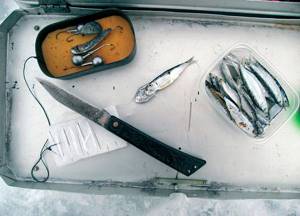
When choosing gear, you need to remember that pike perch is a strong predator. It is large and has a lot of mass.
In order to prevent damage to gear during fishing, you need to purchase high-quality equipment:
- hook. The main condition is durable steel. You can choose either single or double hook. The tip must be perfectly sharp;
- rod The required length is from 50 cm to 100 cm. But it is better to choose 70 cm. The tackle must be durable, capable of not deteriorating under the heavy weight of the catch. You will need a hard whip that will be able to pierce the hard palate of the fish;
- coil. Fishing for pike perch in the winter season is characterized by “work” at depth. Therefore, the reel is required so that 40 meters of fishing line can be wound on it;
- carbine. Some experienced fishermen do not use this part. They attach the bait to the fishing line, tying it in a knot. When choosing several baits, “American” is suitable. Leashes can scare away predators, so many lovers of quiet hunting do not include them in the list of required gear;
- nod. Sometimes part of the equipment is made from a spring. It gives the necessary sensitivity. A hard nod will not work - you may miss a bite with it;
- fishing line You will need a monofilament type of fishing line, the thickness of which should be in the range of 0.2 - 0.3 mm. Wicker is not suitable due to possible loss of flexibility in severe frost.
Special types of equipment
To make pike perch fishing successful, special types of equipment are used.
Namely:
- Vertical glitter. This type includes an additional bait - a spinner. In this case, the dead fish is used to attract a predator by smell. It is recommended to choose a fishing rod with a length of 70 cm. It should have a sharp whip, as well as a spinning reel. You will need monofilament fishing line with a length of at least 40 meters. Its thickness should be 0.3 mm.
- Zherlitsa. This method requires the presence of the correct equipment, which depends on the speed of water movement. The vent must be secured using a 0.4 mm fishing line. After that comes a sinker that can slide. It is secured with a silicone stopper. This detail is capable of adjusting the length of the fishing line to the hook. There is only one requirement for choosing a hook - the material of manufacture is high-quality steel.
- Postavusha. One of the types of zherlitsa. The postavusha is equipped with a sprat. To equip the tackle, you need to attach a jig to the fishing line. After that, tie the leash at a distance of 40 cm. Then comes the hook with the sprat.
Where to fish?
Catching pike perch with sprat is possible with three types of gear:
- fishing rod;
- zherlitsa;
- delivered.
Each fishing option requires its own fishing rods and equipment.
Flashing
In this version of fishing for pike perch on sprat, the use of dead fish is secondary. The main emphasis is on artificial bait:
- spinner;
- balance;
- amphipod;
- handset;
- silicone;
- Rattlin.
Behavior of pike perch in different months of winter
The predator is not active throughout the winter period. The best month for fishing is December. It is in this month, before the dead of winter sets in, that a good bite occurs.
Pike perch has an increased appetite. He moves around the pond in different places. In this regard, in the first winter month the fish will notice the bait faster.
Let's celebrate! When deep winter sets in, the bite decreases. The frequency of bites and the activity of the predator is influenced by the weather. If it is severely cold or strong wind outside, you may not get a catch. The best weather conditions are a windless, not too frosty evening.
Useful tips and common mistakes
It’s good to take the advice of experienced fishermen and avoid mistakes for effective fishing.
Errors:
- Using a fishing line that is too thick. In this case, sensitivity disappears. You can't count on contact with the bait.
- Tying a carabiner at the end of the fishing line. Statistics show that during a sluggish bite, the predator sees only this detail.
- Twister too hard. Especially if the fish behaves passively, it is better to take a soft twister made by a well-known manufacturer.
- Large bait. Sufficient length of the fish is 4 cm.
- Do not change the fishing spot. Many anglers believe that fish need to be hatched. It is not right. If there is no bite, you should not stay in place for longer than 15 minutes.
- Fishing away from the shore. The bulk of the good catch is made closer to the shore. Removal by boat can be done no more than 2 meters.
Helpful Tips:
- To find a suitable place, it is advisable to use an echo sounder. Measuring the depth of the reservoir and determining the bottom topography will significantly save time and increase the opportunity to catch a lot of fish;
- For successful fishing you will need a sharp hook. You can catch a large predator using a sprat. The hook will help you easily pull the catch out of the hole;
- It is better to take an ice screw with a diameter of at least 12 cm;
- Winter fishing for pike perch is an active process. You may have to drill several holes while moving across the ice. Therefore, you will need suitable clothing that can keep out the cold and wick away excess moisture.
To catch pike perch in the winter month, you should remember about the correct choice of fishing location and equipment. When fishing, don’t forget that the predator loves to play with the bait.
Let's celebrate! He will be attracted by the bright aroma of sprat and its natural appearance. Once the bite is successful, it is better not to hesitate - the prey is strong and can fall off the hook of an indecisive fisherman.
Selecting a location
In many ways, the result of fishing depends on proper preparation, namely gear. The fishing rod should have a whip (it doesn’t need to be too long, a medium one will suffice), a 70-90 mm reel, preferably a strong reel, because This is a fairly active fish.
The fishing line must be appropriate - the optimal thickness is 0.35 mm. It is worth remembering that the fishing line for winter fishing must be coated with polymer resin.
https://www.youtube.com/watch?v=HkshRTHHniM
The leash should be small - even 5 cm is enough. If you make it too short or, on the contrary, long, the fish will not swallow the bait, but will bite the line.
We also approach the choice of jigs responsibly - they should be marked, ideally with luminous paint - the fact is that pike perch, due to their nocturnal lifestyle, reacts perfectly to light in the dark.
You can also catch pike perch using a similar rig using girders. Use the guide for pike rigs, the only differences are in the installation that you see on this page.
The best improvement to the equipment would be to use a brighter knocker; there are a great many of them in stores. In general, by using exactly the installation that we recommend, you will already have gear with an enviable advantage over other anglers. Because often the use of a swivel, 3 hooks and a knocker goes by the wayside. But in vain.
How to catch pike perch?
- Fish a large area at once.
- Fish in potentially attractive areas for pike perch, gradually moving from one place to another. Each method is better in some ways and worse in others.
For example, if you actively look for pike perch, the likelihood of catching it is significantly higher. And vice versa - the pike perch can get scared and hide. The fish sometimes bites and is caught only after several hours of fishing after a number of unsuccessful attempts and many holes.
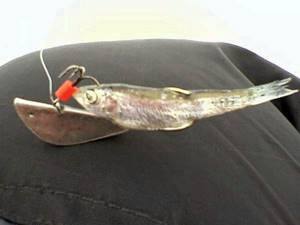
Finding a school of walleyes can be quite challenging during the winter months. Simply feeding the hole in places where there was an active summer bite will not bring the desired result.
For those fishermen who do not want to wait for pike perch on the shore, there is an excellent way to “visit” them in the hole where they usually feed. To organize such fishing, you cannot do without a watercraft, and the method of fishing is called: catching pike perch from a boat in a plumb line.
Place and time
The time when you can catch fish in this way begins early in the morning and can last all day until the evening dawn.
The advantage of this method of fishing is that even a passive pike perch, which is located in a deep hole for an “afternoon rest,” can be easily caught with a vertical lure if positioned for fishing directly above the hole.
When choosing gear for winter fishing for pike perch, you need to take into account the rather large size and strength of this fish. In this regard, all components must be durable and of high quality.
To catch pike perch using sprat in winter, you can try to catch the bait yourself. Such small fish should be caught with the help of a little fish, or “spider”. The device is a frame made of square wire, covered with a fine nylon mesh or gauze. From the corners there are uprights that connect at the top and are tied to a thick fishing line or rope.
But in winter, catching sprat is quite difficult and inconvenient - open water is required. Therefore, it’s enough just to buy fresh frozen fish in the store. You should not choose a large sprat - it should be no more than 5 centimeters in length. Of course, trophy fish will also bite on larger bait. But the average pike perch weighing 2-3 kg will simply bite off half the fish without catching the hook.
There is no need to be afraid of sprat with “rust” - pike perch willingly takes such bait. The main thing is that the fish cannot be defrosted and frozen several times. In this case, it becomes too soft and easily slides off the hook.
It is not easy to find pike perch under the ice - schools move throughout the entire reservoir and you have to walk several kilometers in search of a suitable place.
In this regard, it is better to try to catch pike perch during short stops in the following places:
- pits;
- stuck areas;
- eyebrows;
- depth changes;
- areas with variable currents;
- high and shallow waters at the beginning and end of winter;
- rubble of stones.
The main guarantee of a good catch is knowledge of the reservoir where you plan to catch pike perch.
When fishing with girders, a single hook with a sliding weight and without a steel leash is used; the live bait rises 10 - 20 centimeters from the bottom.
You can also bait a dead frozen sprat onto the hook of a zherlitsa; such tackle is called a postavusha. From time to time you need to approach her and jump up.
Fishing rod for winter trolling
We are preparing the tackle. Take a rigid fishing rod 50–70 centimeters long in order to pierce the jaw of a pike perch that has bitten at a depth of 10 meters. It is advisable to equip the bit with an aluminum reel; it lasts longer and is more reliable. The nod is at your discretion, but in accordance with the sinker used.
It is the sinker, and not the jig or jig - the head. If you fish without a nod, the rod ends in a ring - a tulip. The fishing line most often used is monofilament with a diameter of 0.30 - 0.35 or winter braid with a polymer coating of 0.18. But it should be taken into account that in severe frost it may freeze up and be ineffective. Mormyshka or jig - head.
Fishing with a jig
And now about the hooks and methods of installation for this gear. A few years ago, when fishing for pike perch with sprat was just coming into use, everything was simple and clear. Jig - a head from 15 to 20 grams, above the main fishing line a jig was tied - a boat with one large hook and a sprat was attached behind the eye. Subsequently, fishermen tried to improve the equipment.
Many people use this scheme: fishing line 0.25 - 0.35; lead jig, coated with phosphorus or painted in a bright lemon color; an additional leash 15 -20 centimeters long at a height of 20 - 30 centimeters from the main jig, equipped with a plastic jig with phosphorus filler and a necessarily long shank of the hook to attach the sprat along the entire length of the back.
Pike perch is caught mainly with the upper jig, and rarely takes the lower one. The lower jig head or jig can be replaced with a weight with a swivel or a “Cheburashka”.
When fishing for fish from a hole, the lower jig is hooked onto the ice; it is recommended to make the leash 5 centimeters long from a fishing line of the same diameter or a little thinner. A short leash maintains the sensitivity of the tackle, regardless of which side the pike perch attacks from.
Will need
- bait
- fishing rod with line
- jig or jig - head
- spoon
- nod
The size of the fish should not exceed 5 centimeters. The pike perch has a narrow throat; it cannot swallow large fish whole. If the fish is large, it is cut into pieces. Do not defrost again, which leads to loosening of the bait on the hook, since the fish is oily.
In the intended fishing location, determine by the presence of bites the place where the pike perch is hiding. Use several holes and fishing rods at once, periodically losing with each one - this type of fishing will be much more effective.

